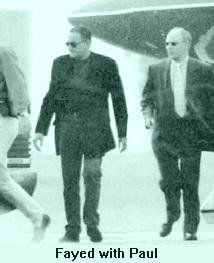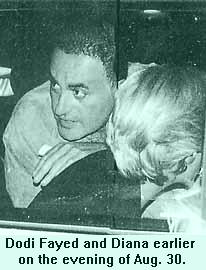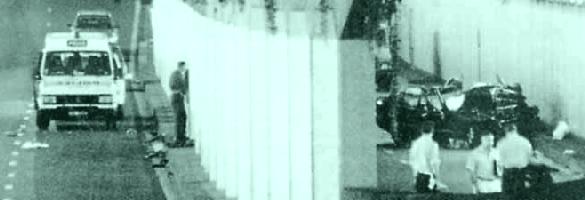

![]()
On the last night of his life, at 8.45 p.m., Dodi Fayed called his step uncle Hassaan Yasseen at the Ritz Hotel to ask him out to coffee later in the evening. Yes, he would be with Diana, Fayed said and “yes, we are going to get married.”
It may not have been as short a love story as it appeared. Fayed had probably started falling for Diana the same time the rest of the world did. On July 29,1981. Fayed left a yacht on the Mediterranean and booked a suite at a luxury hotel in Monte Carlo to watch television—the wedding of Charles and Diana. “I got bored,” says a friend with him at the time, but “Dodi watched the whole thing, from beginning to end.” And now, suddenly, Diana was in his life, at a time when he needed her. “I don’t think he would have given Diana up for anything,” says the friend. “She put him in a different light with his father.”
The domineering Mohammed al Fayed was, says Dodi’s friend someone who tells you whom you can hang out with, what you can do and not do.” Even if the elder Fayed had ordered his son to squire the Princess around, the younger Fayed saw the rebel royal as a way out from under his father’s thumb. “Dodi,” says his friend, “started finding his legs.” And on that Saturday night, it seemed as if an engagement was almost certain, even though, as the French police now say, the fabled Repossi diamond ring was never found in the car or on Diana’s finger. For the Princess apparently had one more thing to do before she could make a public commitment. She had to talk to her sons.

 That
conversation would never happen, and there would be no tomorrows for Dodi and
Diana. That night their lives would be in the hands of a third person. While
paparazzi may have hovered around the fatal event, the car was under the command
of Henri Paul, al Fayed’s trusted deputy security chief at the Ritz. It was
a misplaced trust: a series of autopsy results showed not only that Paul was
drunk, his blood alcohol nearly four times the legal driving limit, but also
that he had ingested a troubling combination of prescription drugs.
That
conversation would never happen, and there would be no tomorrows for Dodi and
Diana. That night their lives would be in the hands of a third person. While
paparazzi may have hovered around the fatal event, the car was under the command
of Henri Paul, al Fayed’s trusted deputy security chief at the Ritz. It was
a misplaced trust: a series of autopsy results showed not only that Paul was
drunk, his blood alcohol nearly four times the legal driving limit, but also
that he had ingested a troubling combination of prescription drugs.
The last day of Henri Paul’s life began with his usual Saturday-morning tennis game. He left the central Paris apartment where he lived alone to join his close friend Claude Garrec at the courts. The men played from 10 until 11, then stopped at the Pelican bar in Paris’ 1st arrondissement. There Paul drank only Coca-Cola. That didn’t surprise Garrec, who knew his best friend to enjoy the occasional wine or pastis (a French liqueur flavored with aniseed that is about as potent as whiskey). At 12.30 Paul said his farewells, telling Garrec that he had to meet Diana and Dodi at Le Bourget airport, where their private jet would touch down from Sardinia at 3.15 p.m. When Paul wheeled up to the private airstrip, he found something else that had become usual, the waiting paparazzi. At this time, Paul was behind the wheel of the black Range Rover that carried the couple’s luggage. He followed a Mercedes 600 driven by Dodi’s regular chauffeur Philippe Dourneau. The two-car convoy was dogged by paparazzi for much of the way but apparently managed to slip past them at some point. Paul turned off and delivered the baggage to Dodi’s apartment near the Arc de Trimphe. Dourneau, with Di and Dodi in the rear, continued on, arriving around 3.45 at the Villa Windsor, the former home of the Duke and Duchess of Windsor, now leased by Dodi’s father Mohammed. According to sources close to the investigation, Dourneau testified to police that Dodi congratulated him on losing the paparazzi on the way from Le Bourget.
Around 4 o’clock, the Mercedes, bearing Di and Dodi, would go to the Ritz, followed by Paul in the Range Rover. For the next three hours, Paul remained at the hotel, where, according to several employees, he had a couple of glasses of Ricard pastis at one of the hotel bars. At 7 p.m., Dourneau drove the couple from the Ritz to Dodi’s apartment near the Arc de Triomphe. It was 7.05 and Paul considered himself off duty.
He appears to have walked to Harry’s New York Bar, two minutes away at 5 rue Daunou. Since the accident, the bar’s manager has systematically thrown out prying reporters, and he insists that Paul was never there. But the French journalist Guilhem Battut of the Journal du Dimanche says he has interviewed two employees of the bar who positively identified photos of Paul, saying he was in Harry’s the night of the accident from about 7.30 to about 9.45. One bartender said Paul had “two or three whiskeys,” ate nothing while there and left after receiving a call on his portable phone.
From there Paul apparently went on foot to the rue Chabannais, where his car was parked across the street from a bar called Champmesle. The Champmesle is a lesbian bar, where, despite his gender, Paul was a regular customer. The burly 41-year old bachelor, a former French air-force officer and an amateur pilot, was a big teddy bear who brought flowers for the bar’s regulars but otherwise left them alone. Josie, the bartender, knew him well. “He never drank much,” she says, leaning on the bar under a garish mural of nude women. “I’ve known him for 20 years. He was a nice guy, gentle. He’d drink Coke, Perrier, maybe a beer.” Josie emphatically denies Paul was an alcoholic and says he appeared perfectly normal that night. “If he’d been a drunk, we would have known about it,” she declares.
Paul came into Champmesle late, around 10, but didn’t drink anything there. He didn’t have time. He had just got a call on his cell phone and announced, “Gotta go to work. See you later.” He jumped into his black Austin Mini and headed to the Ritz. Surveillance-camera videotape released last week shows Paul’s car pulling up in front of the Ritz. Though there was enough space there to park a couple of moving vans, Paul curiously executed several unnecessary back-and-forth manoeuvres. It was then about 10.08. Exactly what he did during the more than two hours it took Di and Dodi to finish their meal is unclear. The French daily Liberation last week quoted an unnamed Ritz employee saying Paul cooled his heels in the hotel’s Hemingway bar drinking pastis. When Paul got up to go, says the paper, he staggered and “knocked into a customer.” The article also said Paul often drank in the Hemingway bar.
But employees in the Hemingway bar tell TIME and CNN that the Liberation account was “exaggerated.” Echoing barkeepers in Paul’s neighborhood, they describe Paul as a moderate drinker. “Often?” says one.
“He came in maybe once or twice every three weeks or so for a drink or two.” Another employee at the Hemingway agrees. “Occasionally he would have a special cocktail 1 prepared for him, and at hotel staff parties he would drink,” he recalls. “But he was not a big boozer.” In the private Ritz Club downstairs, an employee says, “everyone here knows what really happened, but we’re afraid to talk.” He adds, “Monsieur Paul was not responsible. He just took orders.”
Who actually gave the orders remains a mystery — and on that could hinge liability on the part of the Ritz. Paul’s immediate supervisor was away that night. But why bring in Paul to drive? “Because Dodi trusted him,” explains a Ritz staff member.
But could he do his best if he was drinking? A second set of analyses of his blood had confirmed the original tests taken on Aug. 31. Paul had between 1.75 and 1.87 grams of alcohol per litre of blood, nearly four times the legal blood-alcohol limit of 0.5. To that, last week, were added explosive toxicology results: Paul’s blood also contained “therapeutic” amounts of fluoxetine (the generic name for the antidepressant Prozac) and trace amounts of tiapride, a drug used to treat various conditions and is sometimes prescribed to quiet symptoms of agitation and aggressiveness in patients being treated for alcoholism. Alcohol (in Paul’s case, equal to eight or nine shots of straight whiskey) combined with the antidepressants would greatly intensify the side effects of drowsiness, impairing reflexes and vision. Paul’s physician, Dr. Diane Beaulieu-d’Ivernois, says his last visit was onlv two days before the accident; she refuses to discuss his medical records or say why he received the prescriptions.
The final glimpses of Paul on the video inside the hotel show him walking in the corridor, talking with Dodi’s security guards and, at the end of the footage, waiting at the back entrance for the Mercedes S-280 to be driven to the door. French police now say it was Dodi’s bodyguard Trevor Rees-Jones who decided to switch drivers: to have Dourneau, who had driven the couple all day, take the wheel of the Range Rover to decoy the paparazzi and have Paul drive Dodi and Diana. It is impossible to judge from the jerky, heavily edited tape whether Paul was steady or wobbling as he prepared for his assignment. In the last image of him alive, Paul pulls away from the curb at a normal speed and heads down the rue Cambon.
Last week magistrates closed off the Place de l’Alma tunnel and led a grim procession of investigators along the 60 ft. of skid marks that end at the fateful 13th post, graphic proof of Paul’s attempts to retake control of the Mercedes in its final seconds. The group stopped often, checking charts, trying to pin down the truth of what happened. There have been too many stories, some rash, some without substance.
Lawyers for al Fayed claim that film taken from the arrested paparazzi confirm reports that Paul was stunned by flashbulbs. But officials involved in the investigation are discounting the tales of blinding bulbs.
Meanwhile, the charge that photographers did not assist the dying seems to be withering away —though not entirely. While telephone records show that not one of them called emergency services, one photographer apparently tried but dialed a wrong number.
The TIME has discovered who did make the call for medical assistance. A 32-year-old man from a nearby apartment building heard the crash and raced to the tunnel. “I heard tires screeching and heard three crashes,” he said. From his apartment, he saw no motorbikes in the wake of the crash, though. Still, when the witness got to the crash site, he found photographers taking pictures and people starting to approach the wreck. In the car he could see the three men but not Diana, who had been thrown to the floor behind the front passenger seat. The witness spoke to the only man moving, Rees-Jones. “He had half his face ripped off. He was conscious and looked at me,” he says. The witness ran from the tunnel and borrowed a mobile phone to call for help.
When he returned to the scene, he told a squirming Rees-Jones that help was on the way; he interrupted himself to stop two bystanders, not photographers, from opening the car doors. “Don’t do that. You can kill them if you move them,” he warned. But he had come back too late to stop one paparazzo Romauld Rat, from opening Diana’s door and taking her pulse—and her picture. “A young North African man began shouting, saying it was wrong to take pictures and that he should help the victims instead.”
A few minutes later a car from S.O.S. Medecins a volunteer medical group, sped up. Frederic Mailliez an off-duty doctor who had happened by the scene, jumped out; seeing others helping Rees-Jones, he went to help the woman in the rear, whose identity he would discover only the next morning on CNN. Mailliez originally claimed Diana was moaning and gesturing, but he now refuses to describe how she looked or if there were last words.
“This is the kind of situation that creates myth,’’ he says exasperatedly. “[If she did speak], I would say it only to her family, her sons, her husband.”
Police investigators say some witnesses report hearing Diana repeat, “Oh, my God.” But the fervent silence of the most trustworthy witnesses has allowed myths to grow. Mohammed al Fayed claims that Diana’s last “instructions” were relayed to him and that he in turn passed them on to Diana’s sister Sarah. But neither he nor the Spencers are saying more. Last week the Paris daily Le Parisien quoted an unnamed doctor as saying Diana’s last words, as an oxygen mask was put over her face, were “Leave me alone.” But this “witness” is also the one who incorrectly claimed that Dodi’s body was thrown 60 ft. from the car. Lies, conspiracy theories and outrageous tales abound.
What seems almost certain from the doctors at the scene is that Diana was beyond the point of rescue when help reached her. Some still wonder, pointlessly, whether a seat belt would have made a difference for her as it did for Rees-Jones. He alone survives, recuperating slowly and painfully in the same Paris hospital at which the Princess died. His story will be well worth hearing — when he regains consciousness and, more important, if he can recall what happened.

Return to the Plus contents page
![]()
| HOME PAGE | FRONT PAGE | EDITORIAL/OPINION | NEWS / COMMENT | BUSINESS
Please send your comments and suggestions on this web site to
info@suntimes.is.lk or to
webmaster@infolabs.is.lk